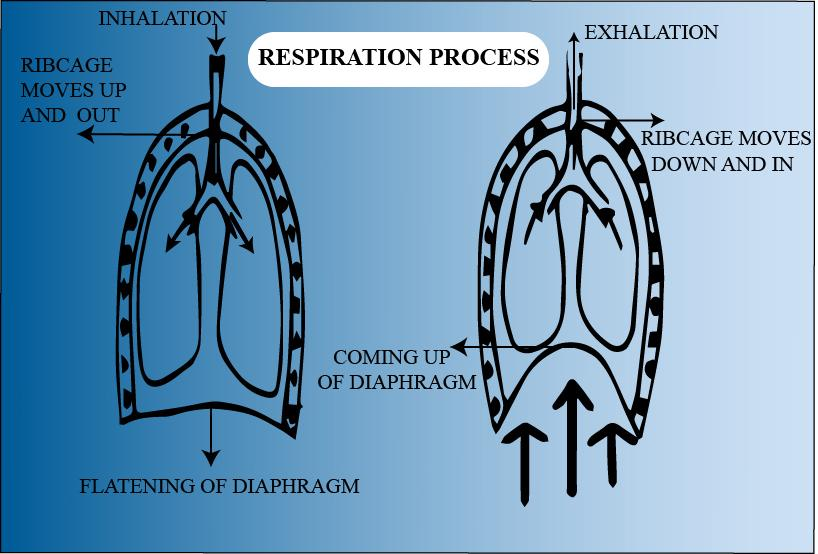
Explain the mechanism for breathing with the help of a labeled diagram, including both the stages-inspiration and expiration.
Answer
576.6k+ views
Hint: The process in which air moves in and out of the lungs is known as breathing. This mechanism helps in regulating the proper supply of oxygen to the body.
Complete answer:
The breathing process is carried out through various respiratory organs such as the nose, pharynx, larynx, trachea, bronchi, and lungs. When we inhale, our diaphragm muscle contracts downward and rib muscles pull upward causing an increase in the thoracic cavity. This increase in the size of the thoracic cavity decreases the internal air pressure and so air from the outside (at a now higher pressure that inside the thorax) rushes into the lungs to equalize the pressures. This is known as inspiration.
This action of breathing in and out is due to changes of pressure within the thorax, in comparison with the outside environment. This action is also known as external respiration. When we exhale, the intercostal muscles relax and diaphragm regains its dome shape, that is, return to their resting positions. This reduces the size of the thoracic cavity, thereby increasing the pressure and forcing air out of the lungs. This is known as expiration.

Additional Information:
-During breathing, the contraction and relaxation of muscles act to change the volume of the thoracic cavity.
-As the thoracic cavity and lungs move together, this changes the volume of the lungs, in turn changing the pressure inside the lungs.
-When the volume of the thoracic cavity increases – the volume of the lungs increases and the pressure within the lungs decreases.
-When the volume of the thoracic cavity decreases the volume of the lungs decreases and the pressure within the lungs increases.
Note: Thorax is another term for the chest. The space between the outer surface of the lungs and the inner thoracic wall is known as the pleural space. This is usually filled with pleural fluid, forming a seal that holds the lungs against the thoracic wall by the force of surface tension. This seal ensures that when the thoracic cavity expands or reduces, the lungs undergo expansion or reduction in size accordingly.
Complete answer:
The breathing process is carried out through various respiratory organs such as the nose, pharynx, larynx, trachea, bronchi, and lungs. When we inhale, our diaphragm muscle contracts downward and rib muscles pull upward causing an increase in the thoracic cavity. This increase in the size of the thoracic cavity decreases the internal air pressure and so air from the outside (at a now higher pressure that inside the thorax) rushes into the lungs to equalize the pressures. This is known as inspiration.
This action of breathing in and out is due to changes of pressure within the thorax, in comparison with the outside environment. This action is also known as external respiration. When we exhale, the intercostal muscles relax and diaphragm regains its dome shape, that is, return to their resting positions. This reduces the size of the thoracic cavity, thereby increasing the pressure and forcing air out of the lungs. This is known as expiration.

Additional Information:
-During breathing, the contraction and relaxation of muscles act to change the volume of the thoracic cavity.
-As the thoracic cavity and lungs move together, this changes the volume of the lungs, in turn changing the pressure inside the lungs.
-When the volume of the thoracic cavity increases – the volume of the lungs increases and the pressure within the lungs decreases.
-When the volume of the thoracic cavity decreases the volume of the lungs decreases and the pressure within the lungs increases.
Note: Thorax is another term for the chest. The space between the outer surface of the lungs and the inner thoracic wall is known as the pleural space. This is usually filled with pleural fluid, forming a seal that holds the lungs against the thoracic wall by the force of surface tension. This seal ensures that when the thoracic cavity expands or reduces, the lungs undergo expansion or reduction in size accordingly.
Recently Updated Pages
Master Class 11 Economics: Engaging Questions & Answers for Success

Master Class 11 English: Engaging Questions & Answers for Success

Master Class 11 Social Science: Engaging Questions & Answers for Success

Master Class 11 Biology: Engaging Questions & Answers for Success

Class 11 Question and Answer - Your Ultimate Solutions Guide

Master Class 11 Business Studies: Engaging Questions & Answers for Success

Trending doubts
10 examples of friction in our daily life

One Metric ton is equal to kg A 10000 B 1000 C 100 class 11 physics CBSE

Difference Between Prokaryotic Cells and Eukaryotic Cells

1 Quintal is equal to a 110 kg b 10 kg c 100kg d 1000 class 11 physics CBSE

Explain zero factorial class 11 maths CBSE

What is a periderm How does periderm formation take class 11 biology CBSE




